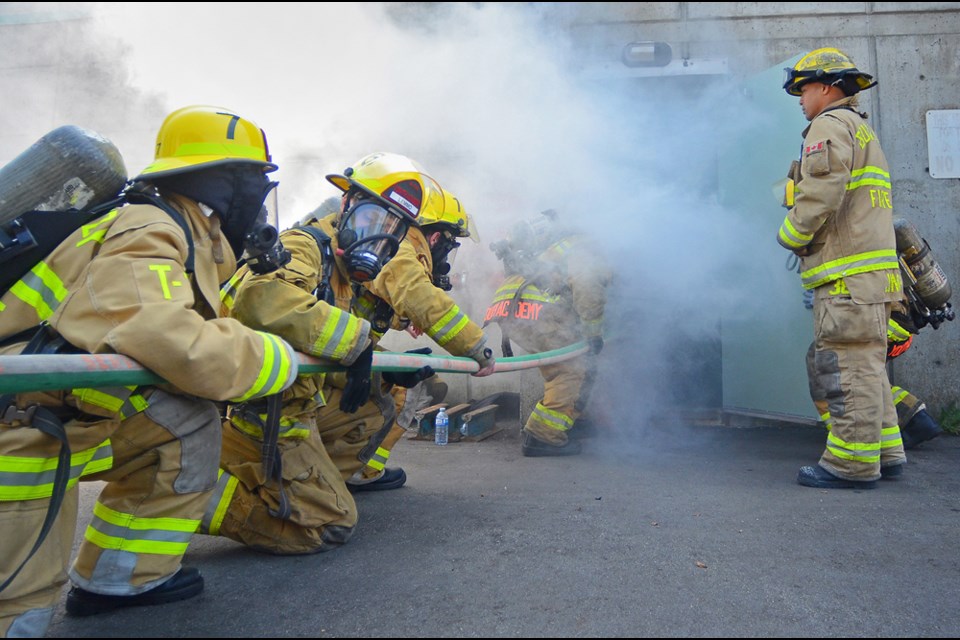There’s no question, sticking your face into an oxygen mask and plunging into a smoked-out building on a hot summer day wearing about 50 pounds of gear gets claustrophobic – even for firefighters.
“Everybody has a little bit of that inside of them,” acting Burnaby Fire Department captain Ian Heatherington told the NOW. “It’s unnatural; it’s kind of like being under water.”
Getting past that natural aversion was just one of the challenges he and the rest of the fire department’s training division set for 13 teens attending its first-ever youth academy last week.
From July 4 to 7, the youths got a chance to try their hands at all kinds of unnatural experiences, including descending a 70-foot tower, climbing a 100-foot ladder, cutting up a car using the jaws of life, handling hydrants and hoses, and, of course, putting out fires.
“We challenged them and then we watched them go. No disappointments at all,” Heatherington said.
By the end, students had also earned Level C first aid certification.
“It’s really cool,” said Burnaby Mountain Secondary student Nolan Andrey, who plans to be a firefighter one day. “It’s stuff I’ve always wanted to do.”
Zahra Samimi, who just graduated from Byrne Creek and has attended the Vancouver Police Department’s youth academy twice, said the fire academy was a lot more challenging – and that was a good thing.
“It’s going to let us know how difficult it’s going to be, and it’s going to help us to decide for our future too,” she said. “It’s easier for us to make our decision for our career.”
The four-day academy, which was free for the youth, cost about $25,000 to put on, according to deputy fire Chief Darcey O’Riordan, who championed the idea, but some of that money was for equipment, like steel-toed boots and coveralls, that will be used again in future camps.
The teens, 11 boys and two girls, were tapped by career counsellors at Burnaby schools.
For the inaugural camp, the district only had a matter of weeks to identify recruits, according to career transition programs consultant Paul Arthur, but in the future the district will make it clear the academy is an opportunity for all Burnaby students, he said.
“Burnaby school district career educators will endeavour to ensure all students understand the opportunities for a career with the City of Burnaby Fire Department and encourage those with a passion and interest to apply to participate in the outreach academy,” wrote Arthur in an emailed statement.
Encouraging a more diverse set of people to consider firefighting as a career is one of the main objectives of the camp, according to Burnaby fire Chief Joe Robertson.
“It’s a chance for us to provide an opportunity for kids from a wide variety of backgrounds to look at firefighting,” he said.
Women have been especially tough to attract to the service, according to the chief.
The fire department currently has only eight female firefighters out of 270.
“We want to better reflect the community we serve,” Robertson said.
While firefighting remains a physical job, the nature of the work is changing, said the chief.
More than 60 per cent of the calls firefighters respond to now are medical calls, he said, and even fighting fires and rescuing people from burning buildings is a team effort.
“There is that mindset of the macho firefighter, and is that what we want people to think of us as?” Robertson said. “I’m sure there’s big, tough firefighters that would want to keep that idea going, but the fire service is changing.”
First-year firefighter Amy Tai said she wishes her hometown of Victoria would have had a youth academy when she was in high school.
“I honestly never even thought about it out of school,” she said of her current career.
She only started considering becoming a firefighter after three summers fighting wildfires for the B.C. Wildfire Service while she was at university.
“I think it just gives them more options,” Tai said of the girls at the youth academy. “It just increases the awareness that it’s not just a guy’s thing.”
Whether she becomes a police officer or a firefighter, Samimi, who came to Canada from Afghanistan four years ago, is ready to challenge the idea some jobs aren’t for girls.
“There is this stereotype – even my mom believes in that – that girls are not good enough for firefighting or being in a dangerous environment, but boys and girls are equal,” she said.



